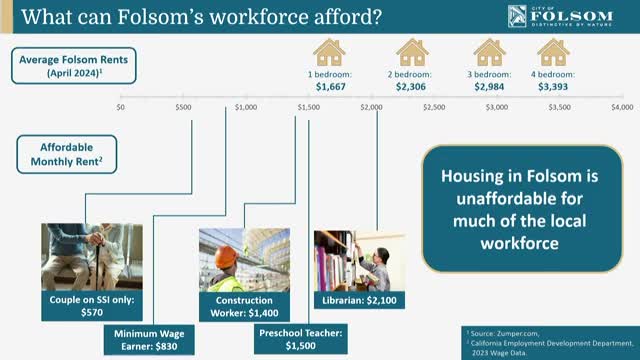Folsom faces housing crisis as students struggle to afford living
August 28, 2024 | Folsom , Sacramento County, California
This article was created by AI summarizing key points discussed. AI makes mistakes, so for full details and context, please refer to the video of the full meeting. Please report any errors so we can fix them. Report an error »

In a recent government meeting, officials expressed growing concerns about housing affordability in Folsom, particularly for students and the local workforce. During discussions, it was revealed that many students do not believe they can afford to live in the area, a sentiment echoed by workforce members who struggle to secure even one-bedroom apartments amid rising home prices and rents.
The meeting highlighted the dual challenges of housing affordability and commuting, as many local workers are forced to travel from outside the city due to the high cost of living. This situation not only affects the quality of life for residents but also exacerbates traffic congestion as more individuals commute into Folsom.
To address these issues, city planners are focusing on strategic development in key areas, such as the east Bidwell corridor and around transit stations, to create housing that is less car-dependent. The goal is to enhance access to job services and public transportation, with improvements to light rail service expected to facilitate better connectivity.
However, the city is currently facing a shortfall in housing capacity, with approximately 600 fewer units than required by the regional housing needs assessment. Officials acknowledged that while there are enough sites for development now, the supply is diminishing due to a trend towards luxury market-rate developments. This necessitates proactive planning to ensure that Folsom can meet future housing demands, especially as the city anticipates a high allocation for regional housing needs in the next cycle starting in 2029.
The discussions underscored the importance of long-term planning in addressing housing shortages and ensuring that Folsom remains an attractive place for both current and future residents.
The meeting highlighted the dual challenges of housing affordability and commuting, as many local workers are forced to travel from outside the city due to the high cost of living. This situation not only affects the quality of life for residents but also exacerbates traffic congestion as more individuals commute into Folsom.
To address these issues, city planners are focusing on strategic development in key areas, such as the east Bidwell corridor and around transit stations, to create housing that is less car-dependent. The goal is to enhance access to job services and public transportation, with improvements to light rail service expected to facilitate better connectivity.
However, the city is currently facing a shortfall in housing capacity, with approximately 600 fewer units than required by the regional housing needs assessment. Officials acknowledged that while there are enough sites for development now, the supply is diminishing due to a trend towards luxury market-rate developments. This necessitates proactive planning to ensure that Folsom can meet future housing demands, especially as the city anticipates a high allocation for regional housing needs in the next cycle starting in 2029.
The discussions underscored the importance of long-term planning in addressing housing shortages and ensuring that Folsom remains an attractive place for both current and future residents.
View full meeting
This article is based on a recent meeting—watch the full video and explore the complete transcript for deeper insights into the discussion.
View full meeting
